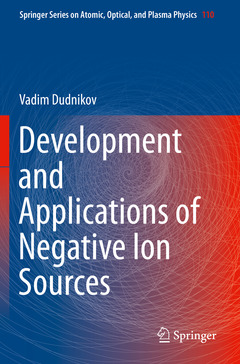Development and Applications of Negative Ion Sources, 1st ed. 2019 Springer Series on Atomic, Optical, and Plasma Physics Series, Vol. 110
Auteur : Dudnikov Vadim

TABLE OF CONTENTS
Introduction ................................................. .................................................. ... ... ......... 3
Chapter 1. Charge exchange Technologies Control of Flow of accelerated particles .. .......................... 7
Features of the charge exchange technology on production and the use of accelerated particles ........... 7
Regularities of the redistribution of accelerated particles on charge and mass states .............. ...............9
Charge exchange Accelerators Tandem.............................................. ..... ............13Supercollimated beams production............................................... ... 16
Charge exchange extraction of particles from accelerators .......................................... ... ...16Charge exchange distribution of accelerated particle beams .......................................... ........................ 17
Charge exchange injection in accelerators and storage rings .................................. 18
Charge exchange injection into magnetic traps for plasma confinement .. . 24
Chapter 2. Methods of negative ions beams production ..................... 26
Features of the of formation and destruction negative ions processes ............ ...................................... 27
Charge exchange method for negative ions beams producing........ ......... 30Charge exchange negative ions sources........... ............................. 32
Features of production of negative ions beams from gas-discharge plasma .. ..... .................................. 39
Elementary processes of formation and destruction of negative ions in a gas-discharge plasma ........... 40
Production of beams of negative ions due to their generation in the volume of plasma ........................ 45Plasma sources of negative ions ................................... ........ 46
Thermionic method of negative ions beams producing..... ... 56Secondary emission (sputtering) method of negative ion beams production.............. ........................... 58
Chapter 3. Surface Plasma Method for negative ions beams production ......... ........................ ........ 64
Investigation of the emission of negative ions from discharges in hydrogen with the adding of cesium 75
Investigation of the energy spectra of H– ions from SPS ......... ............... 85Improved design versions of SPS ...................... ............. 92
The emission properties of the electrodes in the SPS discharges.................. ............... 100
Plasma parameters and the destruction of negative ions during transportation through a plasma ...... 108Cesium in surface plasma sources .............................. ........... 113
Physical basis of surface plasma method of negative ions production ........... .................................... 121
Features of formation of flows of reflected, sputtered and evaporated particles ................. ............... 123
Features of electron capture at electron affinity levels evaporated, sputtered and reflected particles 126
Implementation of the surface-plasma method of negative ions beams production ........................... 137
Chapter 4. Surface Plasma negative ions Sources........................................... ................................. 147
Surface plasma sources of H– ions for accelerators ....... ...... 147The design of SPS for accelerators ............. ................................. ............... 148
Formation of H– ions beams of in SPS for accelerators ............. ........... 154
SPS with Penning discharge for microlithography ........... ............... 159Smiplanotron, Geometric focusing ........................ ................... 160
Semiplanotron for accelerators ............................. ...................... ................... 163Spherical focusing semiplanotron for continuous mode operation.............................. ......................... 165
SPS for heavy negative ions obtaining ................................. 170Development of SPS in foreign centers ................... .......................... ......... 173
Development of SPS with Penning discharge at Los Alamos National Laboratory (LANL) ...................... 177
Development of SPS with Penning discharge in Rutherford Appleton Laboratory ............. ................... 181
Development of SPS with Penning discharge for continuous operation in the INP SB RAS ........... ........ 184
Large volume SPS with beam self-extraction .................. ................. 188SPS of negative ions with arc discharge for neutral beams in Thermonuclear Fusion ... ....................... 197
Development of RF SPS with cesiation for ITER ................................. ............ ........................ 200
Development of a neutral beam injector with RF SPS in the INP SB RAS .......... ........ 204Development of RF SPS with casiation for Spallation Neutron Source ........................ .......................... 209
Carbon films in RF SPS with cesiation ........................................ 216
Development of RF SPS with an external antenna in SNS ...................... ................. 222Development of RF SPS with a solenoidal magnetic field ..... .................. 225
Testing of RF SPS with saddle antenna and solenoidal magnetic field in a large test stand SNS ..... 236
Operation of RF SPS with cesiation in continuous mode ................ ............................ ......... 241Development of RF SPS with cesiation at CERN for Linac 4 ............... ........................... ........ 241
Development of SPS with cesiation in J-PARC .................. .......................... ................................ 247
SPS for production of neutrals with energies in the hundreds of eV .............. ......................... ............. 251
Chapter 5. Transportation of high brightness negative ion beams, space charge compensation, Instability ................................................. .............................................. ... 257
Chapter 6. General Remarks on the Surface Plasma Method of negative ions beams production..... 268
Conclusion ................................................. .................................................. .... .. 276
Bibliography ................................................ ..........................................
Focuses on practical applications without neglecting the fundamental science
Provides a comprehensive reference indispensable to professionals and students alike
Available for the first time in English
Date de parution : 10-2020
Ouvrage de 346 p.
15.5x23.5 cm
